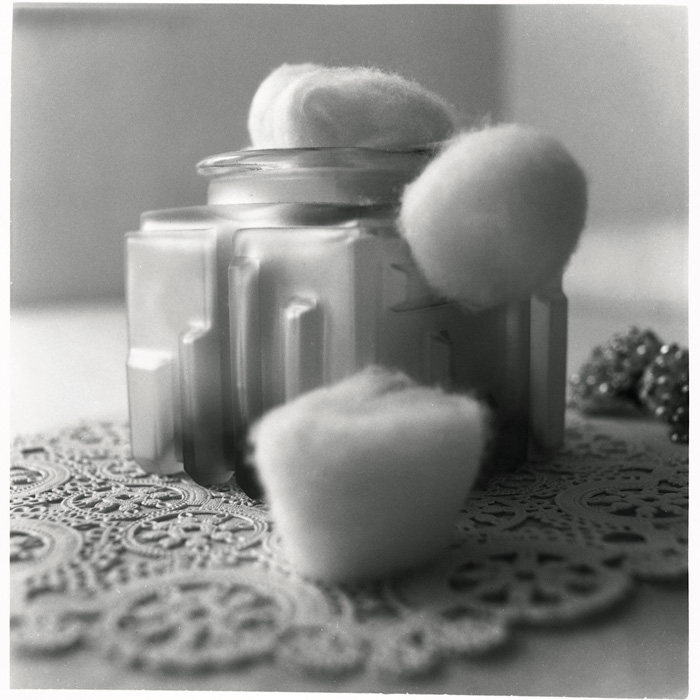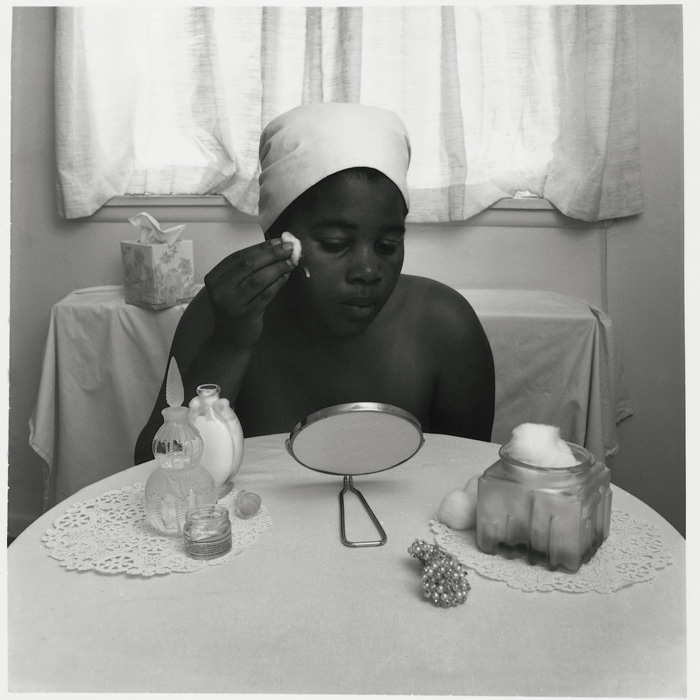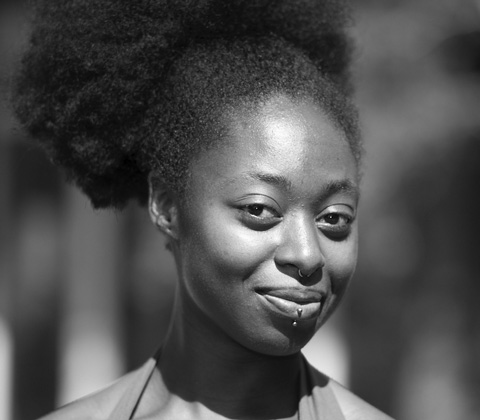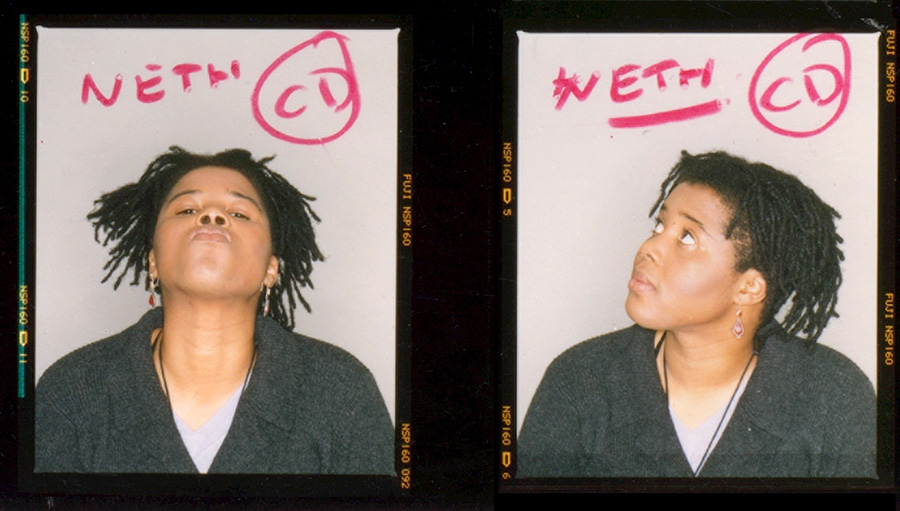



"Walker's assertiveness is not in defining a new way of seeing, but in reminding us that we are in charge of seeing ourselves"

Four frames, four poses, a set of staged portraits forms our introduction to Maxine Walker and her introspective series of explorative photographs on beauty, Blackness, expectation, womanhood, and the self. In one series, the images are laid out in a grid format, four images presenting Walker as she gracefully, teasingly pauses her life, allowing access to her world. The images are reminiscent of those from a photo booth, the emulsion still wet while trying not to smudge the image of yourself. This blurring of the photographed version of one’s self is where Walker excelled.
In collections and exhibitions of her work, Walker can be seen testing out versions of herself. She faces her audience or angles upwards and away while dressed in colour-blocked outfits and matching wigs that shine with sassiness. Walker presents as different iterations and uses the camera as a tool in her roleplaying adventures, skipping from one person to another. On the surface, this is a playful form of dressing up. But in pausing this lightness of movement, the theme of play and performance leads us to thoughts on stereotypes, beauty, Blackness, resistance, visual culture, and how photography has been used as a way of temporarily creating a world where beauty is achievable for all. In a sense, the tired, routine thoughts on beauty have been thwarted by these images. Not because a new path has been set and questions have been definitively addressed and agreed upon, but because the question has been raised, and the position of this assumption has been weakened. Walker's assertiveness is not in defining a new way of seeing, but in reminding us that we are in charge of seeing ourselves. This can be seen in the piece set at a table, curved over a small mirror with a white cotton ball in hand. Is Walker adding or taking away from herself? Is beauty something that was already in existence or an element to be adorned with?

%20maxine%20walker%2C%20untitled%2C%201995.%20courtesy%20of%20the%20artist%20and%20autograph%2C%20london.jpg)
The collection of images that were made, archived, and now exhibited speak to us on beauty, expectation, and the space we are allowed to inhabit and fill with our identities and desires. Take for example, the series of images in which Walker is stripping herself from herself. The tight crops and direct stares are unsettling against the image of Walker peeling away layers of her skin. What does it mean to try to strip ourselves of our most immediate markers to only be met by more of the same layer underneath? Walker explored this process of stripping reality through her photography and recording the journey of discovery, acceptance, and advocacy.
It’s the playfulness and uncertainty that pushes this investigation into the realms of performance and character investigation. It’s as though we’re watching a transformation, of presenting as a Black woman and inviting others to witness the process of beautifying and validating. For those seemingly beyond the bounds of beauty, how do we capture, mimic, and perform it for ourselves and for others? Photography has always held a certain magic to it, in freezing moments and bringing them back to life in a different time and context. In these images, Walker is sending us visions from a space she has created which values and welcomes her Blackness.
_______
Autograph’s touring exhibition of Walker’s work is on display at MAC Birmingham until 30 August. Find out more.
%20maxine%20walker%2C%20untitled%2C%201997.%20courtesy%20of%20the%20artist%20and%20autograph%2C%20london.jpg)
%20maxine%20walker%2C%20untitled%2C%201997.%20courtesy%20of%20the%20artist%20and%20autograph%2C%20london.jpg)

Mariama Attah is a photography curator, writer and lecturer with a particular interest in overlooked visual histories, and understanding how photography and visual culture can be used to amplify underrepresented voices. Attah is Curator of Open Eye Gallery, Liverpool. She was previously Assistant Editor of Foam Magazine. Prior to this, she was Curator of Photoworks, where she was responsible for developing and curating programs and events including Brighton Photo Biennial and was also Commissioning and Managing Editor of the yearly magazine Photoworks Annual.

Rianna Jade Parker reviews Walker's exhibition at Autograph for Frieze Magazine
Read nowCan you spare a few moments? Autograph is carrying out a survey to better understand who our digital audiences are. The survey should take no longer than five minutes to complete. Anything you tell us will be kept confidential, is anonymous and will only be used for research purposes.
The information you provide will be held by Autograph and The Audience Agency, who are running the survey on our behalf. In compliance with GDPR, your data will be stored securely and will only be used for the purposes it was given.
You can take the survey here. Thank you!

.png)
Banner images: 1) Maxine Walker, Cotton Wool. From the series Black Beauty, 1991. © and courtesy of the artist and Autograph, London. 2) Maxine Walker, Cleansing. From the series Black Beauty, 1991. © and courtesy of the artist and Autograph, London. 3) Maxine Walker, Eye Gel. From the series Black Beauty, 1991. © and courtesy of the artist and Autograph, London.
Images on page: 4 + 5) Maxine Walker, Untitled, 1995. © and courtesy of the artist and Autograph, London. 6 + 7) Maxine Walker, Untitled, 1997. © and courtesy of the artist and Autograph, London.
Other images on page: 8) courtesy of Mariama Attah 9) Maxine Walker, contact sheet from the series Untitled, 1995. © and courtesy of the artist and Autograph, London.
Autograph is a space to see things differently. Since 1988, we have championed photography that explores issues of race, identity, representation, human rights and social justice, sharing how photographs reflect lived experiences and shape our understanding of ourselves and others.